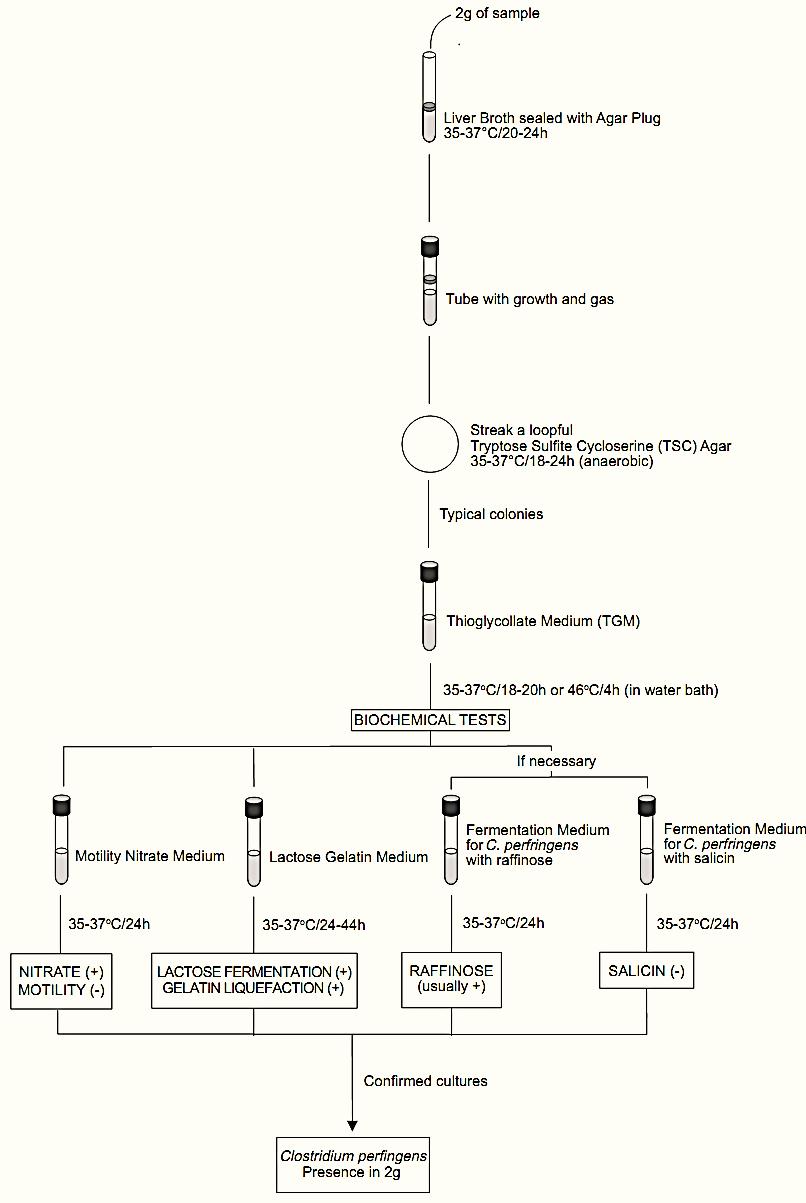


 النبات
النبات
 الحيوان
الحيوان
 الأحياء المجهرية
الأحياء المجهرية
 علم الأمراض
علم الأمراض
 التقانة الإحيائية
التقانة الإحيائية
 التقنية الحيوية المكروبية
التقنية الحيوية المكروبية
 التقنية الحياتية النانوية
التقنية الحياتية النانوية
 علم الأجنة
علم الأجنة
 الأحياء الجزيئي
الأحياء الجزيئي
 علم وظائف الأعضاء
علم وظائف الأعضاء
 الغدد
الغدد
 المضادات الحيوية
المضادات الحيوية| Presence/absence method APHA 2001 for Clostridium perfringens in foods |
|
|
|
Read More
Date: 2025-01-13
Date: 13-3-2016
Date: 14-3-2016
|
Presence/absence method APHA 2001 for Clostridium perfringens in foods
Method of the American Public Health Association (APHA), as described in the 4th Edition of the Compendium of Methods for the Microbiological Examination of Foods (Labbe, 2001). Not applicable to water samples.
This method is recommended for foods likely to contain a small population of injured cells.
Caution: All the steps of the presence/absence method allow the growth (and toxin production) of Clostridium botulinum, which cannot be easily distinguished from C. perfringens. The tubes, plates, and cultures isolated during examination should be handled with care.
1 - Material required for analysis
Presumptive test
• Liver Broth
• Agar Plug (2% agar) sterile
• Tryptose Sulfite Cycloserine (TSC) Agar
• Anaerobic jars
• Anaerobic atmosphere generation systems (Anaero-gen from Oxoid, Anaerocult A from Merck, GasPak® from BD Biosciences, or equivalent)
• Laboratory incubator set to 35–37°C
Confirmation
2- Procedure
A general flowchart for the detection of Clostridium perfringens in foods using the presence/absence method APHA 2001 is shown in Figure 1.

Figure 1. Scheme of analysis for the detection of Clostridium perfringens in foods using the presence/absence method APHA 2001 (Labbe, 2001).
they are supposed to be known to the analyst.
a) Inoculation and incubation. Inoculate about 2 g food sample into 15–20 ml of Liver Broth (before inoculation exhaust oxygen from Liver Broth). Over-lay the medium surface with Agar Plug (2% agar) sterile. Incubate the tubes at 35–37°C/20–24 h and examine for growth and gas production (agar plug displacement).
b) Confirmation. From each tube showing growth and gas production, streak the culture on Tryptose Sulfite Cycloserine (TSC) Agar (with or without egg yolk). Incubate the plates at 35–37°C/18–24 h under anaerobic conditions. To establish anaerobic conditions, use anaerobic atmosphere genera-tion systems (Anaerogen from Oxoid, Anaerocult A from Merck, GasPak® from BD Biosciences, or equivalent). Examine the plates for typical black C. perfringens colonies. From each plate showing growth, select at least one colony suspected to be C. perfringens and continue the procedure for confirmation, as described in the plate count method APHA 2001. Report the result as C. perfringens presence or absence in 2 g of food.
References
Silva, N.D .; Taniwaki, M.H. ; Junqueira, V.C.A.; Silveira, N.F.A. , Nasdcimento , M.D.D. and Gomes ,R.A.R .(2013) . Microbiological examination methods of food and water a laboratory Manual. Institute of Food Technology – ITAL, Campinas, SP, Brazil .
Labbe, R.G. (2001) Clostridium perfringens. In: Downes, F.P. & Ito, K. (eds.). Compendium of Methods for the Microbiological Examination of Foods. 4th edition. Washington, American Public Health Association. Chapter 34, pp. 325–330.



|
|
|
|
لشعر لامع وكثيف وصحي.. وصفة تكشف "سرا آسيويا" قديما
|
|
|
|
|
|
|
كيفية الحفاظ على فرامل السيارة لضمان الأمان المثالي
|
|
|
|
|
|
|
شعبة مدارس الكفيل: مخيَّم بنات العقيدة يعزِّز القيم الدينية وينمِّي مهارات اتخاذ القرار لدى المتطوِّعات
|
|
|